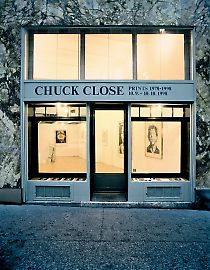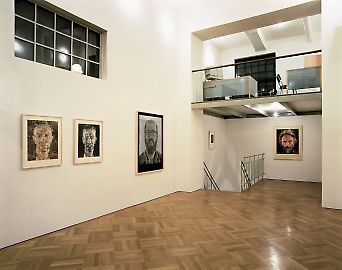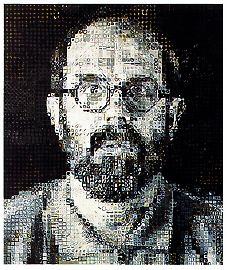Chuck Close --
Chuck Close has developed a strategy for mapping the world in a system of visual metaphors. His paintings, photographs, and prints mark an intersection between representation and abstraction that is simultaneously of the moment and timeless. […]
Closes’s paintings are labor-intensive and time-consuming, and his prints are more so. While a painting can occupy Close for many months, it is not unusual for one print to take more than two years to complete, from conception to final edition. […] The relationship between Close and the master printers is key to the success of his prints. […] Close has been fortunate in working with visionairies who place their trust in what is essentially an unknown outcome. […] Since the late 1970’s, almost all of Close’s prints have been published under the auspices of Richard Solomon at Pace Editions, Inc., in New York.
Close has described himself as “an artist looking for trouble” because pushing the limits of a technique gets him into trouble, and extricating himself from a technical corner becomes an essential catalyst to his creativity. Prints often provide the arena in which he can work out solutions to the aesthetic problems his restless imagination constantly poses. [...] Each time he approaches a print, the making is different, and so is the visual experience. His interpretation of his iconography over time results not so much in similarities as in differences, as if each image were the artist’s first take or initial perception. Close recycles images. His subjects repeat over and over. We become familiar with Phil (Glass), Keith (Hollingworth), Leslie (Close), Alex (Katz), and of course the artist’s own visage. But in many ways Close’s familiarity with the portrayed subject is beside the point. Beyond the physical resemblance inherent in any portrait representation, his print images fascinate because they reveal how they were constructed. The lithograph Phil/Fingerprint, the pulp-paper Phil III, and Phil Sitbite are all based on the same photograph, yet each time Close addresses the image of Phil, he blurs the certainty of achieving a definite depiction. What we become enmeshed in is the freedom with which Close manipulates the convention of representation, maneuvering tonal valuations to suit the enforced order of grid-based seriality. [...]
All of Close’s art presents an abundance of information in a dislocating scale that alters the terms of engagement between viewers and his art. Our role as viewers is to determine the relationship between the parts and the whole and to discern between the surfaces of his representational inventions—brush strokes, fingerprints, dots, dashes, pulp-paper particles—[...]. Close’s portraiture is not so much psychological as perceptual. Whether the surface of his images must be visually pierced, as in his early works, or pieced together, as in his most recent works, the recognition that the sitter is Phil or Keith gets us no further than the basic act of categorizing, of separating A from B. To understand these images, we must return to the artist’s notations, to the means he has used. His individual marks can be read as diaristic entries in his daily effort to express an image. Taken together, they create a portrait of Close’s sensibility, vision, and intellect that is more revealing than any of his self-portraits. [...]
Terrie Sultan, “Chuck Close Prints,” in: exhibition catalogue Chuck Close Prints—Process and Collaborations, Princeton University Press, Princeton, Blaffer Gallery, the Art Museum of the University of Houston, Houston, 2003, pp. 9-16.





